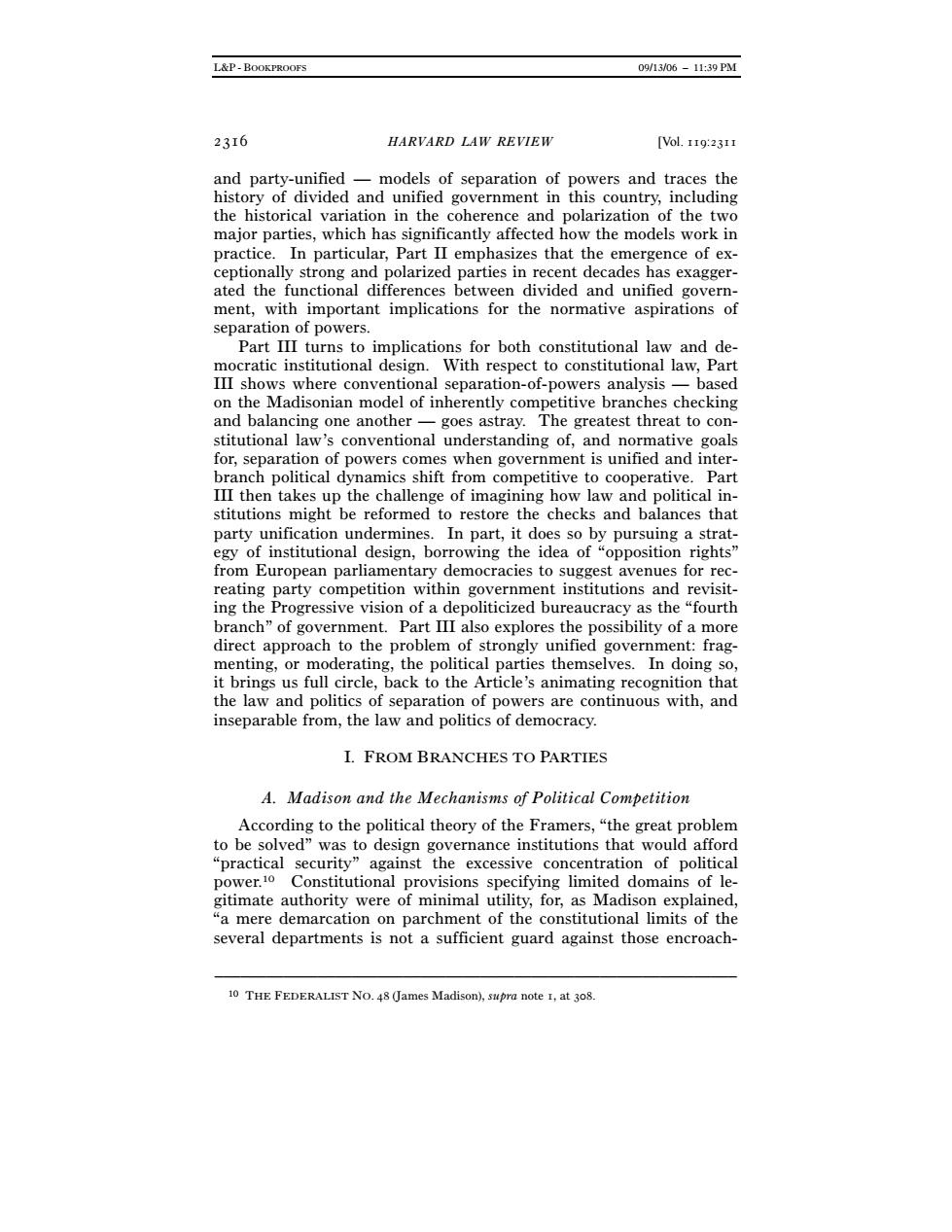正在加载图片...

L&P-BOOKPROOFS 09/13/06-11:39PM 23I6 HARVARD LAW REVIEW [Vol.119:2311 and party-unified-models of separation of powers and traces the history of divided and unified government in this country,including the historical variation in the coherence and polarization of the two major parties,which has significantly affected how the models work in practice.In particular,Part II emphasizes that the emergence of ex- ceptionally strong and polarized parties in recent decades has exagger- ated the functional differences between divided and unified govern- ment,with important implications for the normative aspirations of separation of powers. Part III turns to implications for both constitutional law and de- mocratic institutional design.With respect to constitutional law,Part III shows where conventional separation-of-powers analysis-based on the Madisonian model of inherently competitive branches checking and balancing one another-goes astray.The greatest threat to con- stitutional law's conventional understanding of,and normative goals for,separation of powers comes when government is unified and inter- branch political dynamics shift from competitive to cooperative.Part III then takes up the challenge of imagining how law and political in- stitutions might be reformed to restore the checks and balances that party unification undermines.In part,it does so by pursuing a strat- egy of institutional design,borrowing the idea of "opposition rights" from European parliamentary democracies to suggest avenues for rec- reating party competition within government institutions and revisit- ing the Progressive vision of a depoliticized bureaucracy as the "fourth branch"of government.Part III also explores the possibility of a more direct approach to the problem of strongly unified government:frag- menting,or moderating,the political parties themselves.In doing so, it brings us full circle,back to the Article's animating recognition that the law and politics of separation of powers are continuous with,and inseparable from,the law and politics of democracy. I.FROM BRANCHES TO PARTIES A.Madison and the Mechanisms of Political Competition According to the political theory of the Framers,"the great problem to be solved"was to design governance institutions that would afford "practical security"against the excessive concentration of political power.10 Constitutional provisions specifying limited domains of le- gitimate authority were of minimal utility,for,as Madison explained, "a mere demarcation on parchment of the constitutional limits of the several departments is not a sufficient guard against those encroach- 10 THE FEDERALIST NO.48 (James Madison),supra note I,at 308.L&P - BOOKPROOFS 09/13/06 – 11:39 PM 2316 HARVARD LAW REVIEW [Vol. 119:2311 and party-unified — models of separation of powers and traces the history of divided and unified government in this country, including the historical variation in the coherence and polarization of the two major parties, which has significantly affected how the models work in practice. In particular, Part II emphasizes that the emergence of exceptionally strong and polarized parties in recent decades has exaggerated the functional differences between divided and unified government, with important implications for the normative aspirations of separation of powers. Part III turns to implications for both constitutional law and democratic institutional design. With respect to constitutional law, Part III shows where conventional separation-of-powers analysis — based on the Madisonian model of inherently competitive branches checking and balancing one another — goes astray. The greatest threat to constitutional law’s conventional understanding of, and normative goals for, separation of powers comes when government is unified and interbranch political dynamics shift from competitive to cooperative. Part III then takes up the challenge of imagining how law and political institutions might be reformed to restore the checks and balances that party unification undermines. In part, it does so by pursuing a strategy of institutional design, borrowing the idea of “opposition rights” from European parliamentary democracies to suggest avenues for recreating party competition within government institutions and revisiting the Progressive vision of a depoliticized bureaucracy as the “fourth branch” of government. Part III also explores the possibility of a more direct approach to the problem of strongly unified government: fragmenting, or moderating, the political parties themselves. In doing so, it brings us full circle, back to the Article’s animating recognition that the law and politics of separation of powers are continuous with, and inseparable from, the law and politics of democracy. I. FROM BRANCHES TO PARTIES A. Madison and the Mechanisms of Political Competition According to the political theory of the Framers, “the great problem to be solved” was to design governance institutions that would afford “practical security” against the excessive concentration of political power.10 Constitutional provisions specifying limited domains of legitimate authority were of minimal utility, for, as Madison explained, “a mere demarcation on parchment of the constitutional limits of the several departments is not a sufficient guard against those encroach- ––––––––––––––––––––––––––––––––––––––––––––––––––––––––––––– 10 THE FEDERALIST NO. 48 (James Madison), supra note 1, at 308